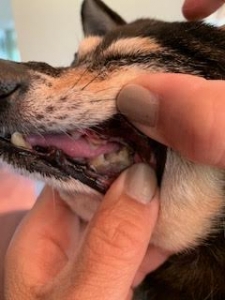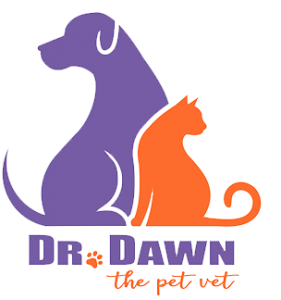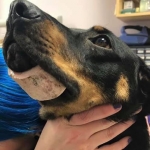I continually am asked about whether a friend or client’s dog can get an anesthesia free dental cleaning. People are not only worried about what they perceive as a greater cost of a full dental procedure with anesthesia, but the risk of anesthesia itself and the recovery thereafter is a main concern. As the far number of patients that do need dental cleanings are elderly, they often have other ongoing diseases or concerns, such as heart disease, etc. There is a very real and current debate in the profession about this subject, and I thought it worthwhile to share with you the pros and cons, and some great resources available, to help answer some of your questions and hopefully guide you in your decision if your pet has been recommended to have his or her teeth cleaned. As February is National Pet Dental Health Month, this is a timely time to start thinking about it.
There are basically two schools of thought, and organizations that support each camp. The AVMA (American Veterinary Medical Association) and AAHA (American Animal Hospital Association) put out their recommendations as:”General anesthesia with intubation is necessary to properly assess and treat the companion animal dental patient. Pet Dental Services, Inc., a national provider of anesthesia-free dentistry, is working on a study to demonstrate the merits of anesthesia-free procedures. The AVDC (American Veterinary Dental College) feels it is inappropriate, and enumerates their reasons on their website, www.avdc.org/AFD. Check it out, as there are abundant resources for pet parents and veterinarians there.
There are no blanket statements that can be made for all pets. First and foremost, there are many dogs, and basically most cats, that simply will not sit still, nor are calm enough to get through the procedure in a way for it to make a big improvement. There are limitations to what you can do and see, in the mouth of an awake patient. You cannot get proper dental radiographs to evaluate what is under the gum, and thus you may be only addressing the superficial issues, effectively using the procedure as a “bandaid” approach to possibly, a more severe underlying problem. Clearly, a thorough exam, cleaning, and extractions if indicated, are best performed while a patient is under anesthesia and intubated. Intubation is the placement of a tube that delivers oxygen and anesthetic gas to the lungs, while also preventing water, blood, bacteria and other particulate matter stirred up during the procedure, from getting down into the lungs. If you have ever had your teeth cleaned with an ultrasonic, water pulsing device, you know how much suction goes on at the same time.
Having said this, there are numerous patients that might benefit from anesthesia free dentals, if they have the personality to permit it. These, in my mind, are not the very old dogs with advanced heart murmurs. They are the dogs that might need a brief scaling months after a full, anesthetized cleaning. When used as an adjunct, these procedures can be spaced out regularly, and delay or possibly make unnecessary, a full anesthetized cleaning in the future. I always encourage clients to try to get their pet to tolerate brushing, and it is always easier to do so after a cleaning, when the teeth and gums are not inflamed. When even that does not work, with the right patient, these awake scalings can help.
Here are some more things to think about. Reasons to choose one or the other, listed by the resources mentioned above.
Reasons NOT to choose anesthesia free dentals:
- Advocates stress that just by removing visible tartar from the teeth that you are improving oral health. The AVDC feels this is not the case because scaling (scraping surface of the tooth with an instrument) the plaque and tartar does not remove the plaque and bacteria from beneath your pet’s gumline. Thus, it does not decrease the risk of periodontal disease. If you consider that the same level of “gross” build up that you can see is also below where you cannot see, think of what you are missing. This cannot be effectively removed while awake.
- Your pet must be restrained during anesthesia free dental cleanings. This can be stressful and painful. If they move, there is increased risk of tissue damage by these sharp instruments.
- There are few visible signs of periodontal infection that are obvious without dental probing and radiographs. As I mentioned, these need anesthesia to be done effectively.
- Painful problems or procedures, such as addressing broken teeth, oral tumors, and periodontal disease require anesthesia to address properly.
- Teeth that have been scaled and not polished are a prime breeding ground for more bacterial growth. Polishing is often not done awake.
- Anesthesia free dental cleanings do not prevent periodontal disease, which will ultimately lead to tooth loss.
- There is no certification process in place for individuals performing these procedures, and not all work is done under the supervision of a licensed veterinarian. Thus there is the potential for much variation in quality.
- The costs of anesthesia free cleanings seems less expensive in the beginning, but ultimately may lead to greater costs if underlying problems continue to progress to more serious, and more expensively remedied issues.
Reasons to consider anesthesia free dentals:
- There are some providers that do only provide cleanings under veterinary supervision.
- Anesthesia-free cleanings may be an option for a young dog with mild plaque and tartar buildup. Thus, it is useful as a preventative measure, in addition to it’s use as adjunct treatment between anesthetic procedures.
- As said previously, this may be the only option for pets that truly cannot go under anesthesia for medical reasons.
- Companies, such as Pet Dental Services, teach their employees behavioral management techniques to better be able to do such dentals with dogs and cats.
- Considering the pricing per practice and these services, there are often less costs involved, and may, ultimately, help pets get some help, as opposed to none, if a dental under anesthesia is cost prohibitive.

Check out the resource:
www.avma.org/petdental
This includes a video demonstrating how to brush teeth, one on periodontal disease, and a podcast on pet dental health, etc.
As always, ultimately, consulting with your dog or cat’s regular veterinarian, is recommended to come up with the best plan for your pet.
Dr. Dawn
Please share and subscribe here








